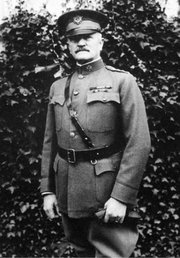Sam Browne belt
|
|

The Sam Browne belt is a wide belt, usually leather, which is supported by a strap going diagonally over the right shoulder. It is most often seen as part of a military or police uniform.
Its origins are uncertain. The earliest known specimen is one from the United States Army which dates to the period of the War of 1812 (it is on display at the National Historical Park Museum in Morristown, New Jersey). Given the design's straightforward simplicity and utility, however, it is probably impossible to determine where or when it was first invented.
The accouterment takes its name from Sam Browne, an officer with the British Army in India, who by most accounts invented it independently sometime during the 1850s. Browne had lost his left arm in 1858 fighting during the Indian Mutiny, and found the contrivance useful in helping him wear his sword thereafter.
Due to its former use as equipment for carrying a sword, it is traditionally only worn by those to whom a sword would historically have been issued, i.e., officers. Throughout most of its modern history, however, its main function has been to carry a pistol, and it was found to be particularly useful with the heavy pistols typically used during the first part of the twentieth century.
In the twentieth century it was a mainstay in the British Army officers' corps, being adopted service-wide in 1900 during the second Boer War after limited use in India, and later becoming popular with military forces throughout the Commonwealth. A sort of gear similar to the traditional Sam Browne belt was also popular with British and Commonwealth armed services; this consists of two vertical straps, one over each shoulder, and its invention is also sometimes attributed to Browne, although other sources say he got the idea from a saddlemaker. After World War II the Sam Browne belt saw a decline in use in the Commonwealth; for example it was phased out by the Canadian military with the unification of the armed services in 1968. Officers and Regimental Sergeant Majors of the British Army and Royal Marines, however, still wear it in formal (No.2) dress and in some versions of full (No.1) dress.
Its modern use in the United States began during World War I, when Army officers arriving in the European theater purchased them, probably in imitation of European officers' uniforms. The style was approved by General Pershing, commander of the AEF; however, the Army as a whole never approved its use, and even went so far as to station MPs at stateside docks to confiscate them from returning officers. Conversely, the style was adopted by the Marine Corps, and is even occasionally worn by officers in the Corps today.
The Sam Browne belt also enjoyed some popularity with civilian police agencies worldwide. It was probably most widely worn in this context during the 1940s and '50s. This use has gradually faded out however due to field safety concerns, although it is still a requirement of the Red Serge worn by the Royal Canadian Mounted Police as their full-dress formal uniform.
External link
- Sam Browne Belt. A full history and a controversy. (http://www.diggerhistory.info/pages-uniforms/sam_browne.htm)
